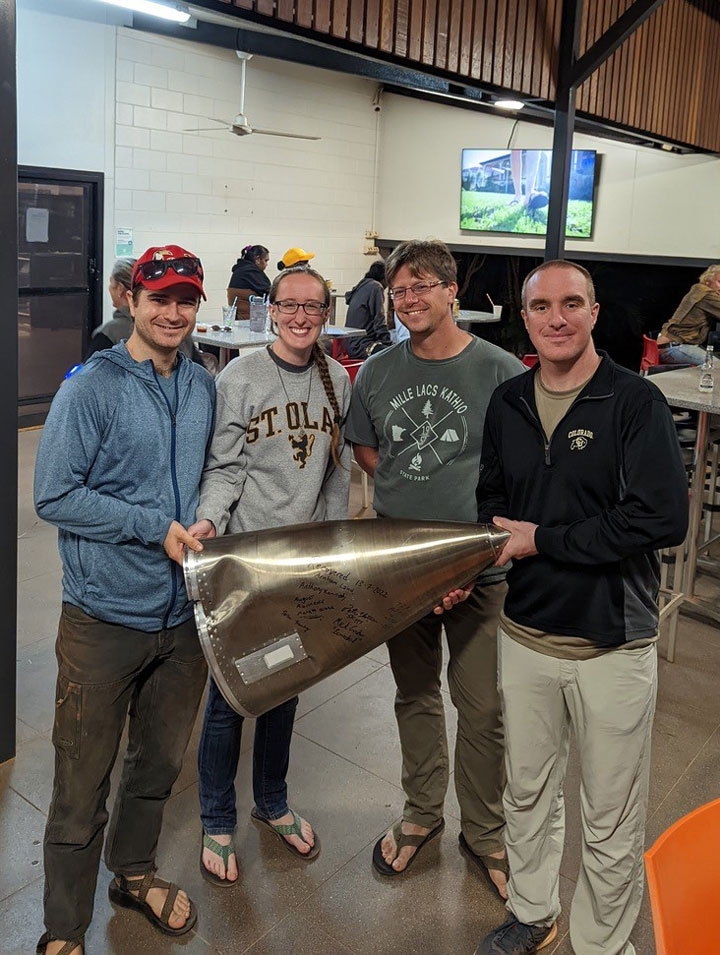
Alex Haughton is a graduate student in the Astrophysical and Planetary Sciences department at University of Colorado Boulder studying ultraviolet instrumentation with sounding rockets. His team has traveled to Equatorial Launch Australia’s Arnhem Space Center near Nhulunbuy, Australia to launch the Dual-channel Extreme Ultraviolet Continuum Experiment (DEUCE) Sounding Rocket and observe the stars Alpha Centauri A & B in extreme ultraviolet wavelengths.
As astronomers, the work we do is literally detached from the world. To be clear, there are material benefits – if you have a phone with a camera on it, the detector technology was developed originally for telescopes. The directions you get with your GPS require general relativity to work properly. And on the time scale of millions of years, the knowledge we seek today will build humanity’s future among the stars.
However, what keeps me satisfied that I’m making a positive contribution to the world is neither the technological advances nor the chance for humans to expand beyond the solar system. It’s that everyone on this planet, regardless of location or culture, has some relationship with space and the stars, and I can help bring that celestial magic a little bit closer to home. Teaching and telling others about what we are doing and seeing their eyes light up? That’s what keeps me coming into work.
After launching a day early (as far as we know this is unprecedented in sounding rocket history), we spent the rest of the week recovering the payload, packing up, visiting beautiful places on the Gove Peninsula, and celebrating a successful campaign. We were not the only ones excited about how well things went. The Yolgnu people, traditional and current owners of the East Arnhem Land, led the recovery efforts for the payload and rocket motors. Yolgnu rangers guided the team through the bush and Yolgnu communities housed the rest of the recovery team while the helicopter flew DEUCE back to the launch site. Dr. Brian Fleming participated in the recovery, and discussed the project with tribal elders, who signed the nose cone.
While having a celebratory dinner at the Boat Club in Nhulunbuy, we were joined by locals who wanted to know exactly what the science mission was. Eager, I launched into my spiel. Astronomers are working to find life signatures on exoplanets, planets orbiting stars other than our Sun. We can measure the composition of exoplanet atmospheres by observing light that passes through them – certain wavelengths of light are blocked by certain molecules and atoms, and certain combinations of molecules and atoms in an atmosphere may indicate the presence of life. However, measuring the light passing through the exoplanetary atmospheres is difficult, and requires extensive knowledge of the light produced by the host star. Our mission, DEUCE, and SISTINE (the mission that launched just before us) together measured the extreme and far ultraviolet spectrum of Alpha Centauri A & B, the closest Sun-like stars outside the Solar System. Ultraviolet light is easily absorbed, so close stars are necessary to collect this light, and Alpha Centauri is in the southern sky, hence the need to travel to Australia. This data is one small piece of what will be a very large puzzle to measure exoplanet atmospheres, but it is a necessary step.
“So you’re looking for aliens?” asked the gentleman in question.
“I mean, not really, but way down the line this could help with that,” I said.
“Cool,” he grinned.
Cool indeed. We brought the nose cone to the Boat Club, and the rest of the evening we posed for pictures with the nose cone and passed it around so folks could touch something that had been to space. The next day while buying some snacks at the grocery store, I am identified by my American accent and asked how the launch went: “I finally got to see this one, the weather was right!” exclaimed the cashier.
It’s good to be going home. There are patches of red on my clothes that I think I will never get off. I miss my friends and family. However, I feel very lucky to have been part of this campaign. Sometimes I get bogged down in the minutiae of the job – what parts need cleaning, what data needs analyzing, what emails need answering. Sharing this work with people, whether the residents of the Gove Peninsula or you, dear reader, reminds me that all this is worth doing simply because space is cool. The stars are cool. They’re out there, and we want to know about them. That’s enough for me.




Does any of the latent heat scape the earth atmosphere after the highest cloud has been converted to ice or rain?